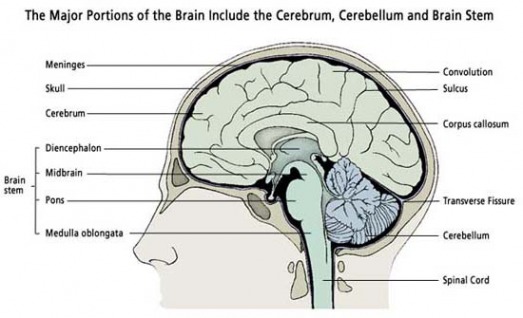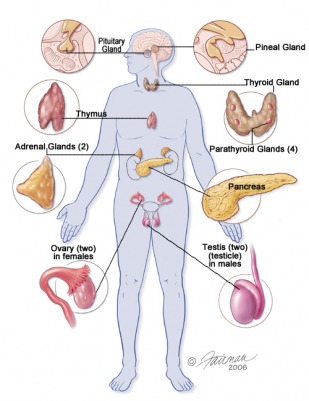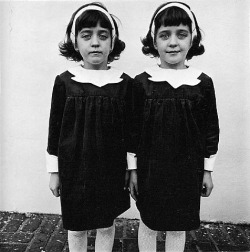Brain Structure

Medulla oblongata is the lower portion of the brainstem. It deals with autonomic functions, such as breathing and blood pressure.
Pons-relays sensory information between the cerebellum and cerebrum; aids in relaying other messages in the brain; controls arousal, and regulates respiration
Cerebellum-a region of the brain that plays an important role in the integration of sensory perception, coordination and motor control.
Related links:
http://serendip.brynmawr.edu/bb/kinser/Structure1.html
The Regions of the Brain

The cerebrum – the front of the brain
The largest part of the brain located in the front is called the cerebrum. The cerebrum is responsible for:
· - Movement
· -Body temperature
· -Touch
· -Vision
· -Hearing
· -Judgment
· -Reasoning
· -Problem solving
· -Emotions
· -Learning
The cerebrum has 2 parts: the right cerebral hemisphere and the left cerebral hemisphere. They are connected at the bottom and have a deep groove running between them. In general, the right cerebral hemisphere controls the left side of the body, and the left cerebral hemisphere controls the right. The right side is involved with creativity and artistic abilities. The left side is important for logic and rational thinking.
The hemispheres of the cerebrum are divided into lobes, or broad regions of the brain. Each lobe is responsible for a variety of bodily functions:
· - Frontal lobes are involved with personality, speech, and motor development
· -Temporal lobes are responsible for memory, language and speech functions
· -Parietal lobes are involved with sensation
· -Occipital lobes are the primary vision centers
·
Information taken from: Princeton Brain and Spine Care http://www.princetonbrainandspine.com/subject.php?pn=brain-anatomy-066
Thalamus, Hypothalamus, Amygdala & Hippocampus

Thalamus
The thalamus is closely integrated with the cerebral cortex and is responsible for the initial processing of all sensory information except olfaction. The thalamus accepts and sifts sensory information and is the part of the brain where sensation is first consciously experienced or felt. The lateral part of the thalamus is involved in the integration of sensory information and sends nerve impulses to the parietal, temporal and occipital lobes for further processing.
The anterior part of the thalamus is involved with attention, memory and learning. The medial part is involved with sensory integration necessary for abstract thinking and long-term, goal oriented behavior.
Information taken from: http://www.thebrainwiki.com/pmwiki.php?n=Forebrain.Thalamus
Hypothalamus A gland which contains neurosecretions that are of importance in the control of certain metabolic activities, such as water balance, sugar and fat metabolism, regulation of body temperature, and secretion of releasing and inhibiting hormones. It is located at the base of the optic chasm.
Amygdala A brain structure with strong connections to the hippocampus and other structures of the limbic system that is vital to emotional arousal and the formation of long-term memories Hippocampus Found deep in the temporal lobe, it is crescent-shaped, and strongly involved in learning and memory formation.
Brain Plasticity
Brain Plasticity Plasticity refers to how circuits in the brain change – organize and reorganize – in response to experience or sensory stimulation. It was once believed that, as humans aged, the brain’s networks became fixed. In the past two decades, however, an enormous amount of research has revealed that the brain never stops changing and adjusting
Endocrine System

Endocrine System A system of ductless glands that regulates bodily functions via hormones secreted into the bloodstream. The endocrine system includes the hypothalamus, pituitary gland, thyroid, adrenal glands, and gonads (ovaries and testes). Hypothalamus- A gland which contains neurosecretions that are of importance in the control of certain metabolic activities, such as water balance, sugar and fat metabolism, regulation of body temperature, and secretion of releasing and inhibiting hormones. It is located at the base of the optic chasm. Pituitary Glands- The pituitary hormones help control some of the following body processes: * Growth
* Blood pressure
* Sex organ functions in both women and men
* Thyroid gland function
* The conversion of food into energy (metabolism)
* Water and osmolarity regulation in the body Thyroid-A butterfly-shaped gland in the neck that secretes thyroid hormones. Thyroid hormones regulate a number of physiologic processes, including growth, development, metabolism, and reproductive function. Adrenal Glands-A pair of small glands, located above the kidneys, consisting of an outer cortex and inner medulla. The adrenal cortex secretes cortisone-related hormones and the adrenal medulla secretes epinephrine (adrenaline) and norepinephrine (noradrenaline). Related Glossary: http://www.aegis.com/pubs/beta/1999/be990414.html#f
Genetics
The study of heredity, focusing on how particular qualities or traits are transmitted from parents to children.
Twins

Monozygotic twins, frequently referred to as identical twins, occur when a single egg is fertilized to form one zygote (monozygotic) which then divides into two separate embryos. Their traits and physical appearances are not exactly the same; although they have nearly identical DNA
Dizygotic twins (commonly known as fraternal twins, but also referred to as non-identical twins or biovular twins) usually occur when two fertilized eggs are implanted in the uterine wall at the same time.
